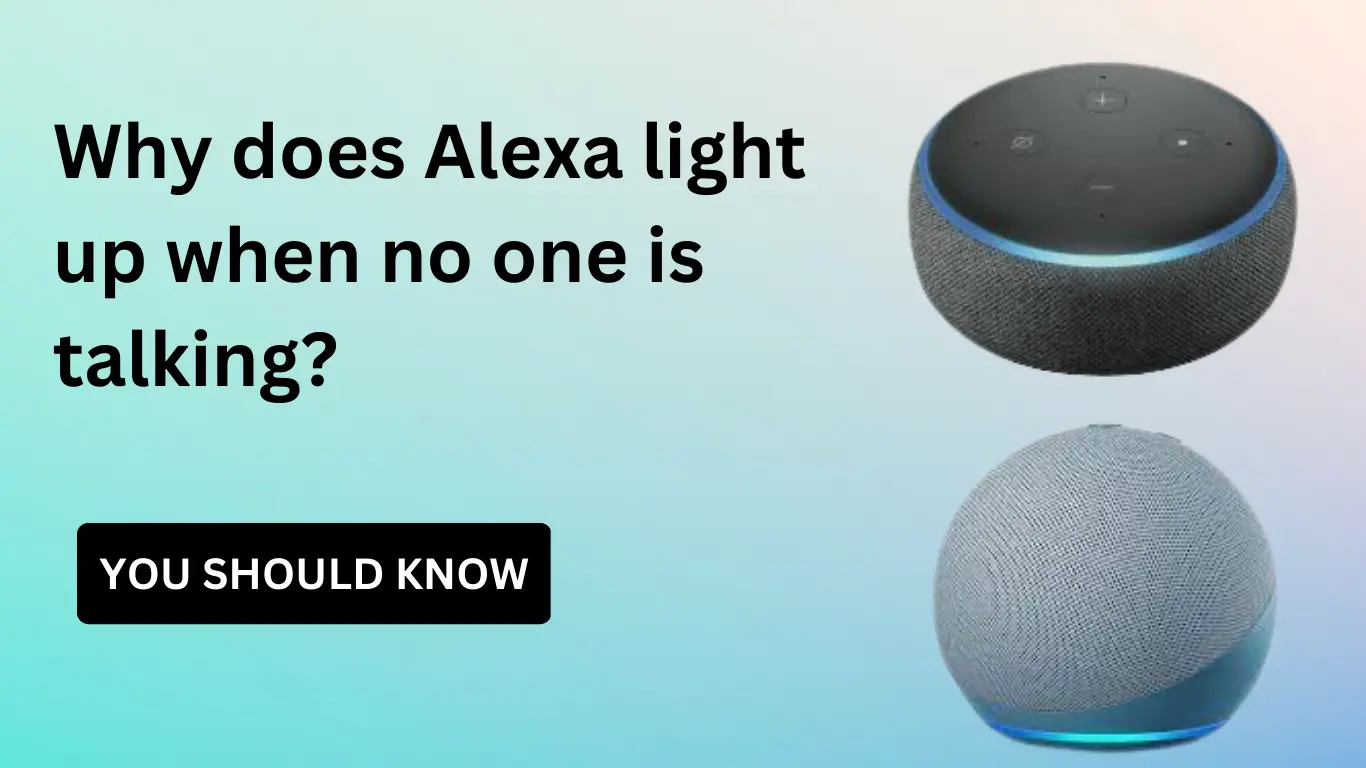Why does Alexa light up When no one is talking [7 Reasons]

The Alexa light up when no one is talking and uses a combination of hardware and software to detect when someone is talking to it.
The device contains microphones that are always on, and it uses these microphones to listen for the “wake word,” which is usually “Alexa. Alexa light up when no one is talking and starts recording audio to process the user’s command or question.
There could be several reasons why Alexa (or any other voice-activated assistant) might appear to “light up” even when no one is speaking.
7 Possible Explanations About Alexa light Up When no One is Talking:
1. False Positives
The device’s microphone may be picking up background noise or another ambient sound that it interprets as a wake word.
One of the most common reasons for false positives with voice-activated assistants like Alexa light up when no one is talking the device’s microphone is picking up background noise or other ambient sounds that it mistakenly interprets as the wake word.
This could include things like a television or radio playing in the background, or even another person talking nearby.
Another way to reduce false positives is to create a custom wake word for the device, which is unique and less likely to originate from background noise.
It’s also worth checking that your device is not too close to other electronic devices such as televisions or speakers, as this can cause interference that can lead to false positives.
2. Always-Listening Mode
Some devices are designing to always listen for the wake word. Which means they can light up even if no one is actively talking to them.
Many modern voice-activated assistants, like Alexa, light up when no one is talking, and always listening for the wake word. The device uses a low-power microphone that is constantly listening for the wake word, even when the device is not actively in use.
This feature is what allows the device to respond quickly when you say the wake word, but it also means that the device may light up even when no one is actively speaking to it.
3. Misinterpretation of Commands
The device may misinterpret a command or question. Furthermore, causing it to take an unintended action or give an unintended response.
A possible reason for a voice-activated assistant like Alexa lighting up when no one is talking is that it may misinterpret a command or question.
This can happen for a variety of reasons, such as poor microphone quality, background noise, or an unclear or ambiguous command.
For example, if you have a speech impediment, the device might misinterpret what you’re saying. Similarly, if you’re in a noisy environment, the device might have a hard time understanding your command due to background noise.
In these cases, the device will light up and perform an action or provide a response.
4. Interference From Other Devices
If other electronic devices in the vicinity are transmitting on the same frequency as the device, this can cause interference and result in false positives or other errors.
A possible reason for a voice-activated assistant like Alexa to light up when no one is talking is interference from other electronic devices that are transmitting on the same frequency as the device.
This can include things like Wi-Fi routers, cordless phones, and other devices that use a 2.4 GHz frequency.
Electronic devices that operate on the same frequency band can create interference which can cause the device to light up in error, give false positives, misinterpret commands or even stop working.
This is because these devices might cause radio frequency noise that can disrupt the signal of the device.
5. Bug or Software issue
There may be a bug in the device’s software that is causing it to function incorrectly. There are several ways to troubleshoot and resolve software bugs.
One common approach is to use debugging tools, such as print statements or breakpoints, to isolate the problem and identify the cause. Once the cause of the bug is identified, it will be fixed by making changes to the code.
Another way to troubleshoot software issues is by reviewing the log files which will provide the error messages and stack traces that may lead to identifying the issue.
6. Echo Cancellation Feature
If your device has echo cancellation features and if it finds any voice commands similar to the wake word, it may activate itself. Echo cancellation is a feature common in voice-enabled devices. Like smart speakers and virtual assistants.
The purpose of this feature is to reduce or eliminate the echoes that can occur when the device’s microphone picks up its output sound.
This can happen when the sound is played back through speakers located close to the microphone.
Causing
1. The device hears its voice commands, which can activate it mistakenly.
2. Alexa or other similar devices are not able to pick up low-volume speech, so if you happen to speak close to the device, it may misinterpret it as the Wake word.
3. “Alexa,” is the word or phrase that a voice-enabled device is programmed to listen for to activate and begin processing voice commands.
4. In some situations, the device can have difficulty hearing or understanding the wake word. In this situation, when the word is spoken at a low volume or with background noise present.
As some examples include my Alexa randomly waking up at night or my Alexa lighting up at 3 am. My Alexa randomly lights up blue and green and my except lights up yellow.
If the device is having trouble hearing the wake word, there are a few things you can try to improve the device’s performance.
7. It Might be intentional illumination
Device manufacturers may have added this feature to let users know when the device is listening or processing a command. And to indicate that it’s ready to receive input.
Many voice-enabled devices, such as smart speakers and virtual assistants, have been designed with visual indicators, such as lights or LEDs, that can help users understand.
And when the device is listening or processing a command. These indicators will use to indicate that the device is ready to receive input.
For example, when a device is listening to the wake word, its light indicator might turn on. Once the device has been activated, the light indicator may turn off or change color to indicate that it is processing a command.
Once the command is processed, the device’s light indicator may turn off or change color again to indicate that it is ready to receive another command.
It’s worth noting that many of these issues can be resolved by adjusting the device’s settings, recalibrating its microphone, or performing a software update.
If you’re experiencing problems with your voice-activated assistant and none of these explanations seem to fit, it’s a good idea to check the manufacturer’s website for troubleshooting advice or contact customer support for further assistance.
Conclusions
Based on the information provided, it is likely that the Alexa device is experiencing a technical issue or malfunction. This could be caused by a variety of factors, such as a software glitch or hardware malfunction. It is recommended to troubleshoot the device and check for any updates or fixes. If the problem persists, contacting customer support or contacting the manufacturer for further assistance may be necessary.
FAQ
Is Alexa Always Listening?
Alexa, like many other virtual assistants, is designed to always be listening for its wake word, which is “Alexa” by default. When it detects the wake word, it begins recording and processing the user’s request. However, users can also turn off the microphone manually on their device to prevent it from listening.
How To Stop Alexa from Saying by The Way?
To stop Alexa from saying “by the way” when providing additional information, you can adjust the settings in the Alexa app. Here’s how:
- Open the Alexa app on your device.
- Tap on the menu button in the top-left corner.
- Tap on “Settings.”
- Tap on “Device Settings.”
- Select the device you want to adjust.
- Scroll down to the “Device Responses” section.
- Toggle off the switch next to “By the way” to disable it.
After making this change, Alexa will no longer say “by the way” when providing additional information.
How Can You Tell If Someone Is Listening to Alexa?
There are a few ways to tell if someone is listening to Alexa:
- The Alexa device’s indicator light will turn on when it is actively listening and responding to a command.
- You may hear the “Alexa” wake word spoken, followed by a command or question.
- The Alexa app on a smartphone or tablet may show activity.
- If you are in the same room as the Alexa device, you may hear the device responding.
It’s important to note that not all Alexa devices have indicator lights. So the other methods may be more reliable for identifying when Alexa is being used.

I am a content writer and affiliate marketer with a passion for crafting engaging and informative content that drives traffic and sales. With years of experience in the industry, I have honed my skills in SEO, social media marketing, and email marketing to help businesses reach their target audience and achieve their goals.
